Malaysia E-Commerce Market Size
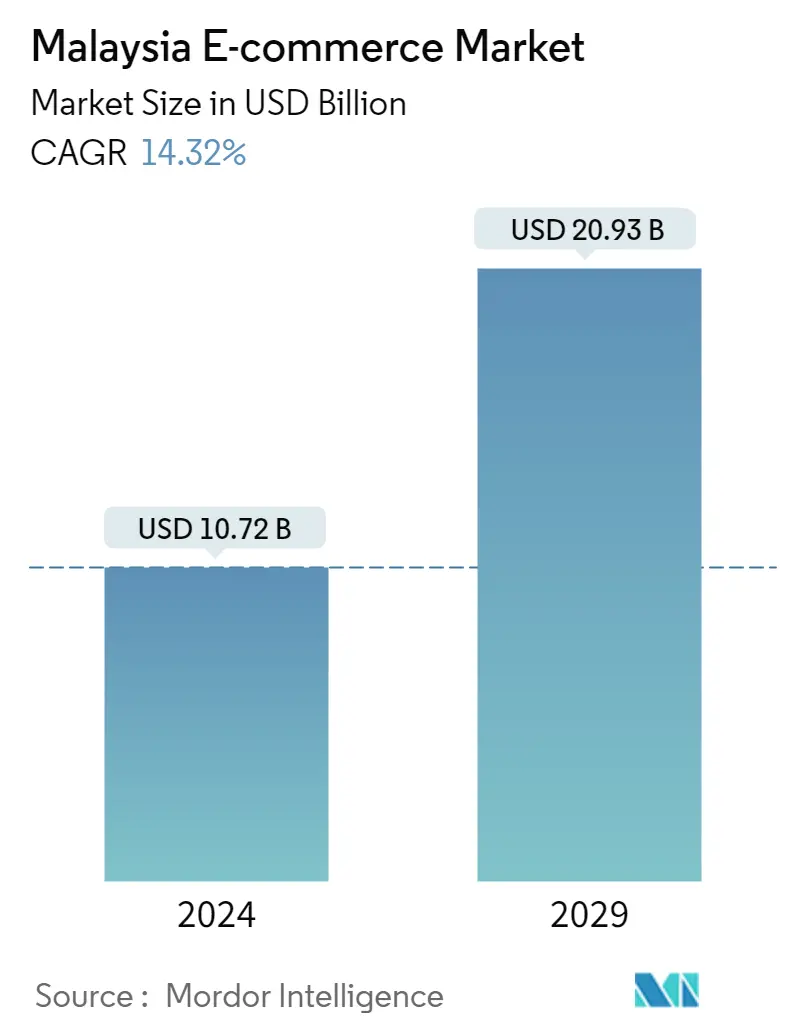
| Study Period | 2019 - 2029 |
| Base Year For Estimation | 2023 |
| Market Size (2024) | USD 10.72 Billion |
| Market Size (2029) | USD 20.93 Billion |
| CAGR (2024 - 2029) | 14.32 % |
| Market Concentration | Medium |
Major Players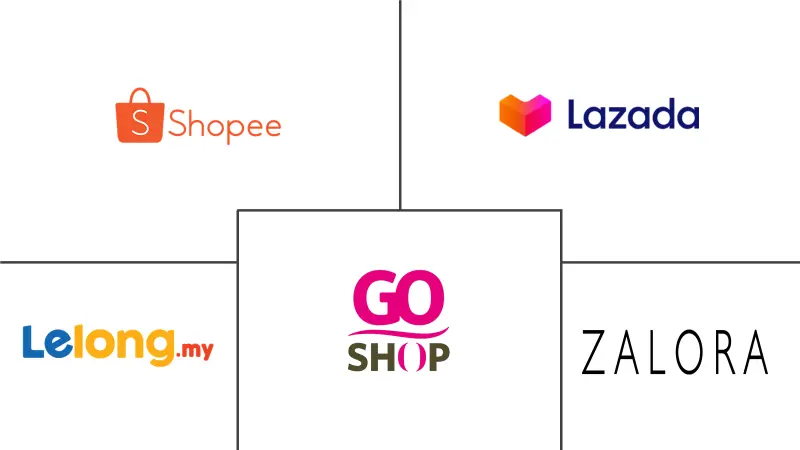
*Disclaimer: Major Players sorted in no particular order |
Need a report that reflects how COVID-19 has impacted this market and its growth?
Malaysia E-Commerce Market Analysis
The Malaysia E-commerce Market size is estimated at USD 10.72 billion in 2024, and is expected to reach USD 20.93 billion by 2029, growing at a CAGR of 14.32% during the forecast period (2024-2029).
According to the International Trade Administration, Malaysia has a high e-commerce adoption rate, aided by a sizable population of active internet users (27.4 million, or 80%) and high mobile phone penetration (84.2%) in the previous year. Additionally, as of the last year, the nation had 39.9 million mobile connections and 28 million users on social media.
- The Malaysian government has been proactive in supporting and nurturing the e-commerce industry. Launching initiatives such as the Digital Free Trade Zone (DFTZ) and the Digital Economy Blueprint has provided a conducive environment for e-commerce businesses to thrive. These initiatives offer benefits such as tax incentives, infrastructure development, and regulatory support, attracting local and international players to invest in Malaysia's e-commerce market.
- Additionally, the government is taking several steps to promote the growth of e-commerce in the nation. The National E-Commerce Council, comprised of several ministries and government entities, was established by the government to improve the implementation of the National E-Commerce Strategic Roadmap 2.0 (NeSR2.0). The National Council of Digital Economy and 4IR have approved the National E-commerce Strategic Roadmap 2.0 (NeSR2.0), guided by three objectives: boosting e-commerce adoption, enhancing ecosystem growth, and bolstering e-commerce laws and regulations.
- According to Malaysia's Commercial Crime Investigation Department (CCID), e-commerce fraud cases have increased from 3,318 cases accounting for MYR 22.39 million in recent years to 8,162 cases accounting for MYR 57.73 million reported until the previous year. The tenacity of fraud has hindered the market's expansion, which has eroded purchasers' faith.
- The e-commerce market in Malaysia has increased due to the Covid-19 pandemic, which has shifted consumer behavior from offline to online shopping and prompted retailers to enhance their online presence. The industry has also benefited from government support, the increasing internet and smartphone penetration, the rising disposable income, and the growing demand for e-commerce logistics.
- Moreover, according to the Malaysian Communications and Multimedia Commission (MCMC), during the COVID-19 outbreak, internet traffic in Malaysia jumped by more than 30%. Malaysia's government has also acknowledged the expansion of e-commerce in the country and has assisted MSMEs in adopting e-commerce. Furthermore, the government actively supported e-commerce adoption through digital initiatives such as "Buy Malaysia" and #SayaDigital.
Malaysia E-Commerce Market Trends
Government initiatives supporting the increased adoption of digital solutions
- The government introduced the SME Digitalization Grant to encourage digital adoption among small and medium-sized enterprises (SMEs). This initiative provides financial assistance for SMEs to invest in digital solutions and technologies, including e-commerce platforms, digital marketing, and inventory management systems. The grant has been instrumental in helping SMEs embrace e-commerce and enhance their competitiveness in the digital marketplace.
- According to the Malaysian Finance Ministry, the digital sector generated 22% of Malaysia's GDP in the previous year. By 2025, more than 500,000 additional jobs are anticipated to be developed. As a result of such developments, the government consciously works with the private sector to promote the use of digital services by consumers and to support small businesses with incentives and support.
- The administration presented an eight-point action plan. Some alternatives are rearranging current economic incentives and lowering non-tariff barriers (consumer protection, cross-border, e-Fulfillment). Others include strategically funding chosen e-commerce companies and promoting national brands to advance international e-commerce.
- One of the government's other objectives is to encourage MSMEs to use advanced technology and e-commerce. Additionally, digital free trade zones were established to promote international e-commerce and improve MSMEs' access to capital.
- Furthermore, through agencies like Malaysia Digital Economy Corporation (MDEC), the government has established programs to nurture and support the growth of e-commerce businesses. For instance, the eTRADE Program provides funding and capacity-building assistance to local micro, small, and medium-sized enterprises (MSMEs) to enhance their e-commerce capabilities. This program aims to increase the number of local businesses participating in e-commerce and promote their visibility in the global market.
- The Digital Economy Blueprint, launched recently, sets the direction for Malaysia's digital transformation across various sectors, including e-commerce. It outlines strategies and initiatives to drive digital adoption, promote talent development, enhance digital infrastructure, and create a supportive regulatory environment. The blueprint aims to propel Malaysia's digital economy forward and position the country as a regional hub for e-commerce and digital innovation.
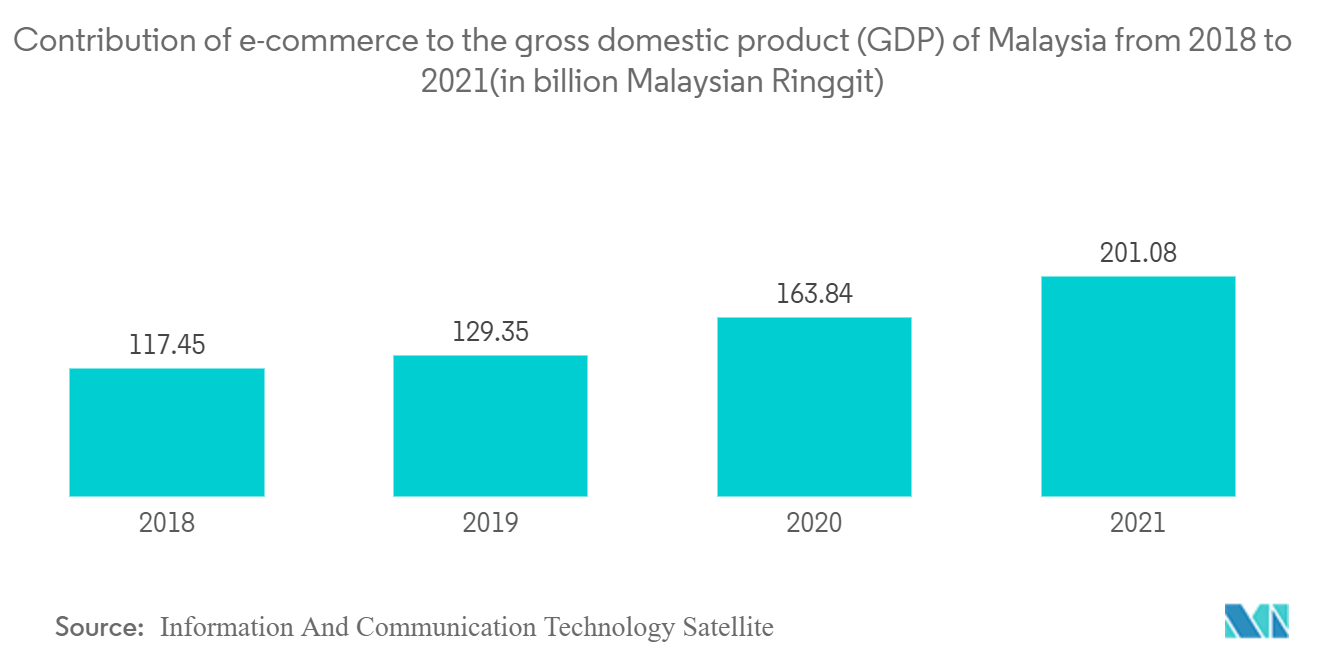
Consumer Electronics Segment Accounts for Significant Share
- According to the Malaysian Department of Statistics, the value of manufactured consumer electronics in Malaysia in the previous year was roughly MYR 38.59 billion (USD 8.61 billion). The sales value of manufactured consumer electronics has changed throughout time. However, e-commerce has played a critical role, with regular people increasingly purchasing things through internet platforms.
- Through consumer electronics, technology can improve people's lives. The advent of Industry 4.0 has accelerated the development of novel and sophisticated consumer goods, increasing demand for smarter consumer goods that incorporate advanced technologies such as IoT (Internet of Things), AR (augmented reality), VR (virtual reality), and AI (artificial intelligence).
- Smartphones, household appliances, computers, laptops, and other consumer electronics such as television, game consoles, wearables, and so on are examples of consumer electronics. With the increasing number of product launches in the consumer electronics sector, e-commerce is becoming increasingly popular for acquiring consumer electronics.
- With advantages such as door-to-door shipping and cheaper logistical costs for suppliers, there has been a surge in demand for e-commerce in consumer electronics. Furthermore, because companies are constantly inventing new products, e-commerce for consumer electronics will likely grow.
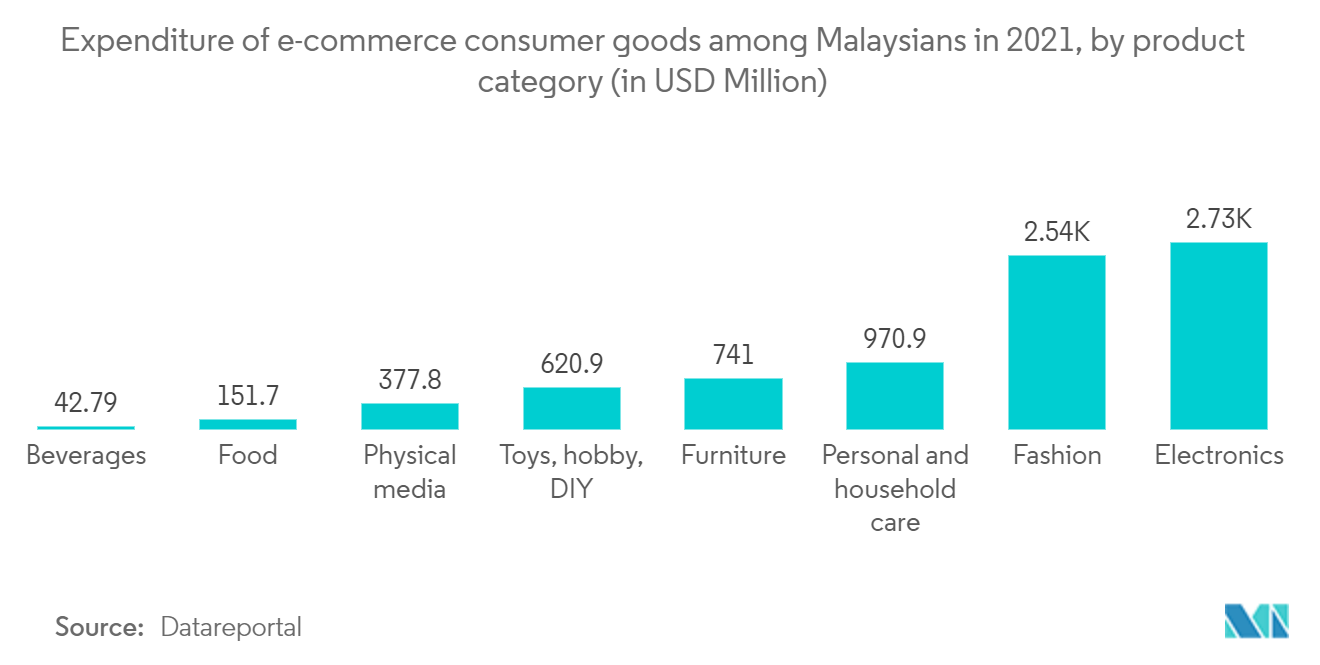
Malaysia E-Commerce Industry Overview
Due to a few big market competitors, the level of rivalry in the Malaysian e-commerce market is medium. The number of local and global brands in the e-commerce sector is increasing, which increases market competition.
- April 2022 - Mouqy Eyeware opened a new e-commerce store to expand its national reach. Customers can also utilize the website's virtual try-on tool before purchasing to check how different frame types look on their faces.
- April 2022 - Unifi Business has expanded its offerings for Malaysian micro, small, and medium enterprises (MSMEs). For example, the Unifi e-commerce hub offers a single integrated platform with an easy-to-use interface. Businesses can use this tool to sync their offline and online sales channels, manage product stocks and orders, track sales and revenue, and manage social media inquiries.
Malaysia E-Commerce Market Leaders
Shopee Pte. Ltd.
Lazada Group
Lelong.my
Zalora Group
Astro GS Shop Sdn Bhd
*Disclaimer: Major Players sorted in no particular order
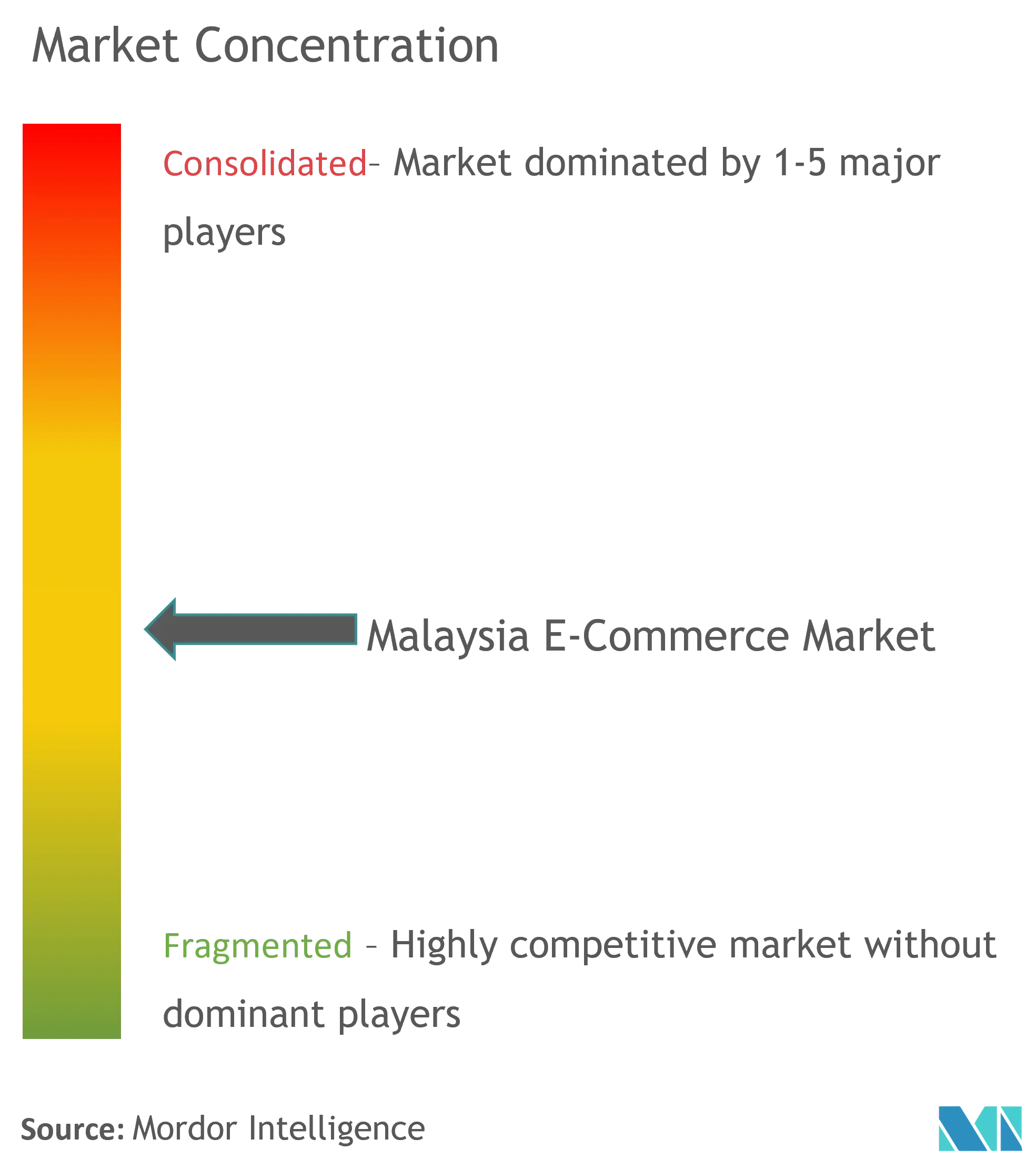
Malaysia E-Commerce Market News
- May 2022 -Malaysia registered 89% smartphone adoption rate. Over 29.5 million Malaysians, or more than 89% of the nation's population, use the Internet. Malaysia's mobile commerce market is expected to develop at a rate of 19.7% CAGR to reach RM41.11 billion (USD 8.78 Billion) by 2023, exceeding the country's overall e-commerce growth.
- September 2022 - Lazada Group formed an e-commerce anti-counterfeiting cooperation. Lazada worked with partners such as BMW and HP to combat the trafficking and sale of counterfeit goods on Southeast Asia's online marketplaces. The Southeast Asian e-commerce Anti-Counterfeiting Working Group, or Seca, has pledged to collaborate with stakeholders to address "changing issues surrounding the trade in counterfeit goods in online retail" and to work together to protect intellectual property (IPR) and consumers in the e-commerce ecosystem.
- July 2022- Malaysia's government introduced Malaysia Digital, a program designed to boost the country's digital economy and help Keluarga Malaysia. Malaysia Digital is a national strategic initiative led by the Ministry of Communications and Multimedia (K-KOMM) through the Malaysia Digital Economy Corporation (MDEC) to encourage and attract companies, talents, and investment while allowing Malaysian businesses and the Rakyat to play a leadership role in the global digital economy.
Malaysia E-Commerce Market Report - Table of Contents
1. INTRODUCTION
1.1 Study Assumptions and Market Definitions
1.2 Scope of the Study
2. RESEARCH METHODOLOGY
3. EXECUTIVE SUMMARY
4. MARKET INSIGHTS
4.1 Market Overview
4.2 Industry Attractiveness-Porter's Five Forces Analysis
4.2.1 Bargaining Power of Suppliers
4.2.2 Bargaining Power of Buyers
4.2.3 Threat of New Entrants
4.2.4 Threat of Substitute Products
4.2.5 Intensity of Competitive Rivalry
4.3 Key market trends and share of e-commerce of total Retail sector
4.4 Impact of COVID-19 on the e-commerce sales
5. MARKET DYNAMICS
5.1 Market Drivers
5.1.1 Increase in adoption of digital Solutions
5.1.2 Promotion of e-commerce by the Government Sectors
5.2 Market Challenges
5.2.1 Online Frauds and Cybersecurity Issues
5.3 Analysis of key demographic trends and patterns related to ecommerce industry in Malasiya (Coverage to include Population, Internet Penetration, ecommerce Penetration, Age & Income etc.)
5.4 Analysis of the key modes of transaction in the ecommerce industry in Malasiya (coverage to include prevalent modes of payment such as cash, card, bank transfer, wallets, etc.)
5.5 Analysis of cross-border ecommerce industry in Malasiya (Current market value of cross-border & key trends)
5.6 Current positioning of Malasiya in the ecommerce industry in South East Asia
6. MARKET SEGMENTATION
6.1 By B2C ecommerce
6.1.1 Market Segmentation - by Application
6.1.1.1 Beauty and Personal Care
6.1.1.2 Consumer Electronics
6.1.1.3 Fashion and Apparel
6.1.1.4 Food and Beverage
6.1.1.5 Furniture and Home
6.1.1.6 Others (Toys, DIY, Media, etc.)
6.2 By B2B ecommerce
6.2.1 Market size for the period of 2017-2027
7. COMPETITIVE LANDSCAPE
7.1 Company Profiles
7.1.1 Shopee
7.1.2 Lazada Group
7.1.3 Lelong.my
7.1.4 Zalora
7.1.5 Astro GS Shop Sdn Bhd
7.1.6 eBay Inc.
7.1.7 Presto Mall Sdn Bhd
7.1.8 ezbuy (EZbuy Holdings Limited)
7.1.9 Hermo Creative (M) Sdn Bhd
7.1.10 Sephora Digital SEA Pte Ltd
- *List Not Exhaustive
8. INVESTMENT ANALYSIS
9. FUTURE OUTLOOK OF THE MARKET
Malaysia E-Commerce Industry Segmentation
E-commerce includes business-to-business (B2B) and business-to-consumer (B2C) transactions and internal organizational transactions that support these activities. The analysis tracks essential market factors, underlying growth influencers, and significant industry vendors, which helps market estimations and growth rates in Malaysia throughout the anticipated period. The study examines the overall impact of COVID-19 on the ecosystem. The report's scope includes market sizing and forecasting for B2B and B2C segmentation, with the B2C channel further segmented by application.
The Malaysian e-commerce market is segmented into B2C e-commerce (beauty and personal care, consumer electronics, fashion and apparel, food and beverage, furniture and home) and B2B e-commerce. The market sizes and forecasts are provided in terms of value (USD) for all the above segments.
| By B2C ecommerce | ||||||||
|
| By B2B ecommerce | |
| Market size for the period of 2017-2027 |
Malaysia E-Commerce Market Research FAQs
How big is the Malaysia E-commerce Market?
The Malaysia E-commerce Market size is expected to reach USD 10.72 billion in 2024 and grow at a CAGR of 14.32% to reach USD 20.93 billion by 2029.
What is the current Malaysia E-commerce Market size?
In 2024, the Malaysia E-commerce Market size is expected to reach USD 10.72 billion.
Who are the key players in Malaysia E-commerce Market?
Shopee Pte. Ltd., Lazada Group, Lelong.my, Zalora Group and Astro GS Shop Sdn Bhd are the major companies operating in the Malaysia E-commerce Market.
What years does this Malaysia E-commerce Market cover, and what was the market size in 2023?
In 2023, the Malaysia E-commerce Market size was estimated at USD 9.38 billion. The report covers the Malaysia E-commerce Market historical market size for years: 2019, 2020, 2021, 2022 and 2023. The report also forecasts the Malaysia E-commerce Market size for years: 2024, 2025, 2026, 2027, 2028 and 2029.
What government initiatives are supporting the E-commerce Market in Malaysia?
Government Initiatives supporting the e-commerce Market in Malaysia are: a) National E-commerce Strategic Roadmap b) Aiming to double E-commerce growth c) Digital Free Trade Zone (DFTZ) to facilitate cross-border E-commerce
Malaysia E-Commerce Industry Report
The Global Ecommerce Market, experiencing a significant upward trajectory, is driven by a surge in consumer demand across various segments, including retail, travel, and hospitality. This expansive growth, highlighted by the sale of goods from food to luxury items through digital channels, is revolutionizing consumer shopping habits and business operations. With a focus on sustainability, the shift towards eco-friendly practices like paper packaging materials aligns with consumer preferences for environmentally responsible products. The market's evolution is supported by technological advancements and mobile device adoption, making online shopping more accessible. In Malaysia, the eCommerce sector is witnessing remarkable growth, as detailed in Mordor Intelligence™ Industry Reports, which offer insights into market share, size, and revenue growth rates. This dynamic environment presents numerous opportunities for innovation, catering to changing consumer needs and technological progress. For detailed insights, Mordor Intelligence™ provides free report PDF download, showcasing Malaysia's eCommerce analysis and market forecast.
